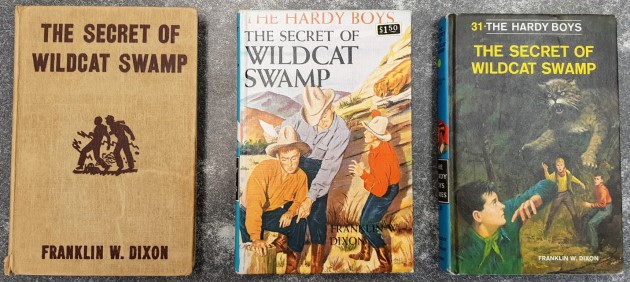The Hardy Boys is a popular series of detective/adventure books for boys chronicling the fictional adventures of teenage brothers Frank and Joe Hardy. The original Hardy Boys series was produced between 1927 and 1979 by a group of authors under the pen name Franklin W. Dixon.
The Hardy Boys is a creation of the Stratemeyer Syndicate, the creators of dozens of successful book series such as the Rover Boys, the Bobbsey Twins and Tom Swift, and later, Nancy Drew. Edward Stratemeyer conceived of the Hardy Boys in 1926 with the creation of plot outlines that would become the first volume of the series. Various ghostwriters were employed, under contract of secrecy, to pen the actual stories. The first author was Leslie McFarlane, whose writing defined the literary style of the series, as well as the personalities and nuances of its characters. McFarlane authored volumes 1—16 and 22—24, which are generally regarded as the best works of the series. His 1976 autobiography, Ghost of the Hardy Boys, provides substantial background information on the series, as well as the Stratemeyer Syndicate as a whole.
From 1959 to the mid-70s, substantial revisions to the first 38 titles were made. This was done to modernize outdated vernacular, reduce story length, age the characters and remove the ethnic and racial stereotypes prevalent in many of the early books. The result of this process varied widely, with some books being changed only slightly while others had their entire plot and storyline thrown out. At any rate, the revised versions are those that are commonly found and are available here at Exodus.
Original versions had 23-25 chapters; revised versions all have 20 chapters and later copyrights. You will sometimes find original versions here.
- Early editions are listed with their original title and have either their original brown cover or a rare dustjacket. We believe these versions go to book #40.
- Unrevised "blue cover" reprints are marked as (vintage), quickly identified by their brown endpapers and confirmed by number of chapters. We seldom see these, so don't keep them always visible on the site as a general rule, making exceptions when the cover is different from the matte version.
- Revised "blue color" reprints from the 50s-70s are marked as (matte). These ones often look like the vintage ones, but have endflaps with b/w line drawings. They consistently have 20 chapters.
- Newer, glossy versions are simply listed as a Hardy Boys with series number.
The first 58 stories and the 38 revisions, along with the Detective Handbook and its revision, are considered by many collectors to form the Hardy Boys "canon."


Below is a list of the entire series:
- Tower Treasure
- House on the Cliff
- Secret of the Old Mill
- Missing Chums
- Hunting for Hidden Gold
- Shore Road Mystery
- Secret of the Caves
- Mystery of Cabin Island
- Great Airport Mystery
- What Happened at Midnight
- While the Clock Ticked
- Footprints under the Window
- Mark on the Door
- Hidden Harbor Mystery
- Sinister Sign Post
- Figure in Hiding
- Secret Warning
- Twisted Claw
- Disappearing Floor
- Mystery of the Flying Express
- Clue of the Broken Blade
- Flickering Torch Mystery
- Melted Coins
- Short-Wave Mystery
- Secret Panel
- Phantom Freighter
- Secret of Skull Mountain
- Sign of the Crooked Arrow
- Secret of the Lost Tunnel
- Wailing Siren Mystery
- Secret of Wildcat Swamp
- Crisscross Shadow
- Yellow Feather Mystery
- Hooded Hawk Mystery
- Clue in the Embers
- Secret of Pirates' Hill
- Ghost at Skeleton Rock
- Mystery at Devil's Paw
- Mystery of the Chinese Junk
- Mystery of the Desert Giant
- Clue of the Screeching Owl
- Viking Symbol Mystery
- Mystery of the Aztec Warrior
- The Haunted Fort
- Mystery of the Spiral Bridge
- Secret Agent on Flight 101
- Mystery of the Whale Tattoo
- Arctic Patrol Mystery
- Bombay Boomerang
- Danger on Vampire Trail
- Masked Monkey
- Shattered Helmet
- Clue of the Hissing Serpent
- Mysterious Caravan
- Witchmaster's Key
- Jungle Pyramid
- Firebird Rocket
- Sting of the Scorpion
|
Our Honest Opinion:
These are decidedly not classics. The storylines are formulaic, with the two boys and their chums having all sorts of adventures—usually catapulted into a mystery by some crime or catastrophe. They track down clues, threatening the villain(s) with exposure. Eventually, they are generally captured and threatened with death. But the villain then boasts about how the felony was committed before the boys somehow manage to escape and bring the police to their aid. (This is an area we appreciate: while many books have kids solving mysteries while rebelling against authority, the Hardy boys have the full support and assistance of their father and the police force.)
While the books do include crimes like murder and theft, and occasionally dabble with occultic symbols, we are not too concerned about the content being dangerous for kids (for instance, occultic images are usually meant to be a scare tactic and can be explained scientifically). What we are concerned with is the triviality of the books. They are fun to read, but they are fluff, and little—either in terms of knowledge or in worldview—can be gained from them. Although we don't think it's necessary to prevent kids from reading these, we would recommend that parents keep the time spent reading them to a minimum!
Did you find this review helpful?